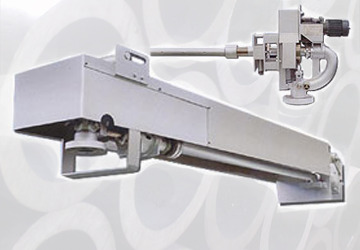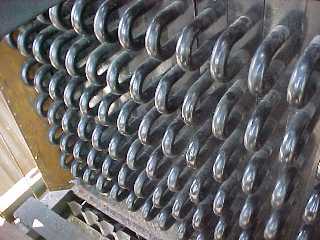
The Ultimate Guide to Sootblower Replacement Parts
Sootblowers are essential components of industrial boilers. Just like the name implies, they can remove soot and ash buildup from a boiler’s heat exchange surfaces.
Home » Three Types of Soot Blowers and Their Applications
When it comes to industrial boilers, efficiency and reliability are paramount, and soot blowers are essential tools for consistently maintaining those traits. Soot blowers help sustain optimal performance and prolong equipment lifespan.
Soot blowers utilize either high-pressure compressed air or steam to remove soot and ash from a boiler’s surface. They come in various types, each with unique applications and advantages. Below are three different types of soot blowers and their diverse applications in industrial boiler systems.
Soot blowers are classified into three main types: rotary, retractable, and fixed/wall. Each type offers unique features and perks tailored to specific boiler configurations and cleaning requirements.
Rotary soot blowers have a compact design and internal placement within the boiler.
Rotary soot blowers remain inside the boiler at all times. There are nozzles along the blowing tube or element. This internal placement saves space, as most units occupy space within the boiler.
These soot blowers are best for cleaning the boiler’s superheater, economizer, and air heater sections.
Because rotary soot blowers have a simple design, they’re easier to maintain and have lower upfront costs than other types.
Retractable soot blowers are versatile tools that can be retracted from the boiler when not in use, helping to clean, inspect, and save space. Retractable soot blowers include two common types: part-retractable and long retractable soot blowers (LRSB) or insertable kinetic (IK) blowers.
Retractable soot blowers are easier to maintain and inspect when not in use because they can be retracted from the boiler.
Part-retractable soot blowers are handy for high-temperature regions like the combustion chamber. Other types may be less effective in this setting because they must be equipped to handle high temperatures and pressure.
Fixed or wall soot blowers are small units connected to the exterior boiler wall. Multiple units are needed to cover the entire boiler surface.
These soot blowers are connected to the exterior boiler wall. A short nozzle enters the boiler, the furnace water walls, and the surrounding area. When not in operation, the soot blower nozzle retracts.
Fixed soot blowers are great options for placement in areas facing high temperatures, whereas not all other types of soot blowers may be up to that challenge.
Each type of soot blower serves its own essential function and is tailored to different industrial boiler applications, depending on needs.
Rotary soot blowers are best for cleaning superheaters, economizers, and air heaters. Their compact design and internal placement help them take up less space for more efficient cleaning.
Long retractable soot blowers are versatile, but they are especially preferred for high-temperature regions like combustion chambers.
Fixed or wall soot blowers are best for localized cleaning in high-temperature zones. However, they’re only ideal if you can purchase multiple units to ensure coverage of the entire surface.
Each soot blower type offers pros and cons that can help you choose the best one for your boiler’s needs.
Rotary soot blowers’ compact design and internal placement save plenty of space. Their small size also makes them easier to maintain. However, these soot blowers sometimes have limitations in reach compared to other types.
Retractable soot blowers offer versatility above all. The soot blowers’ retractable design makes them easier to maintain and inspect. That said, retractable soot blowers may require a more complex approach to installation. They may also have higher upfront costs, though they often prove worth the investment if retractable soot blowers suit your needs.
Fixed or wall soot blowers are fantastic for handling high-temperature areas and are also a go-to choice for more localized cleaning. However, they have limitations in reach. You’ll need multiple units to get comprehensive coverage from this type of soot blower.
Your choice of soot blower type will depend on many factors: boiler section, space limitations, temperature, cleaning requirements, and more. Whether you opt for the compact design of rotary soot blowers, the high heat tolerance of retractable soot blowers, or the localized cleaning capabilities of fixed/wall soot blowers, they are ideal tools for your facility’s needs. Understanding the types of soot blowers in boiler usage and the benefits of each better equips you to make an informed decision.
Need help choosing your perfect soot blower? With over 20 years of experience, Industrial Boilers America can help you narrow down the best option for optimal efficiency, equipment lifespan, and cost-worthiness. Contact us today to get started.
At Industrial Boilers America, we lead in providing the development, licensing, and deployment of Industrial Power plants. We partner with other leaders of communities and governments to foster long-term relationships that create sustainable energy, jobs, and social responsibility. Our philosophy that sustainability should be rooted in the betterment of the ecosystem rather than profit allows us to provide services that will enable our partners to reinvest in themselves, resulting in a sustainable community.

Sootblowers are essential components of industrial boilers. Just like the name implies, they can remove soot and ash buildup from a boiler’s heat exchange surfaces.

Boilers provide essential heating and steam generation for industries ranging from power production to manufacturing. To ensure safety, efficiency, and functionality, rely heavily on sophisticated

Industrial boilers are essential for keeping the world moving. Understanding the critical industrial boiler parts ensures efficient operation, safety, and longevity of equipment. Main Industrial